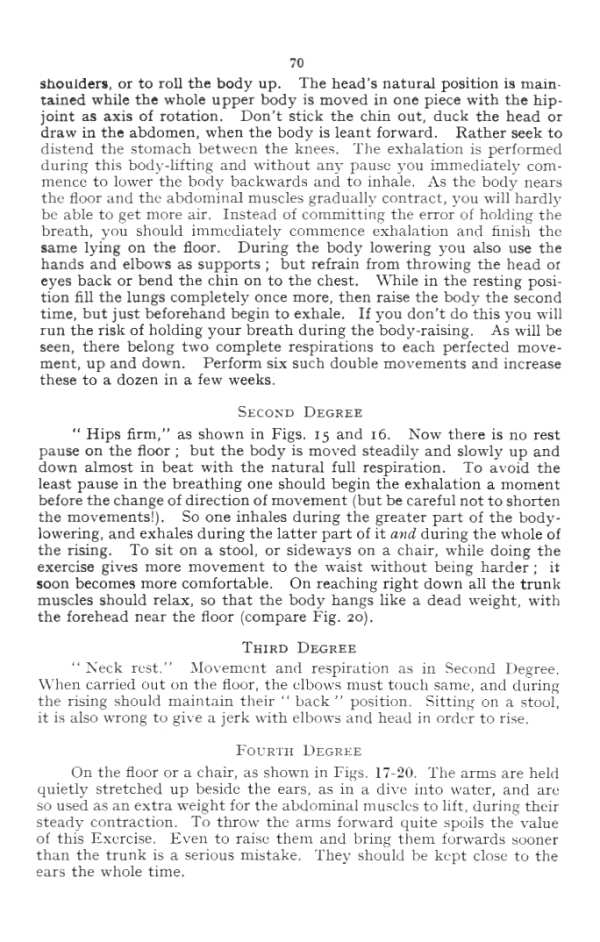73679 system 70

70
shoulders, or to roli the body up. The head's natural position is inam tained while the whole upper body is moved in one piece with the hip-joint as axis of rotation. Don't stick the chin out, duck the hcad or draw in the abdomcn. when the body is leant forward. Rather seek to
distend the stornach between the knees. Tiie eshalation is performed during this body-lifting and without any pausc you immediately com-rnence to lower the body backwards and to inhale. As the body nears the floor and the abdominal museles gradually contract. you will hardly be able to get morę air. Instead ot committing the error of holding the breath, you should immediately commence cshalation and finish the same Iying on the floor. During the body lowering you also use the hands and elbows as supports ; but refrain front throwing the head or eyes back or bend the chin on to the chest. While in the resting position fiU the lungs completely once morę, then raise the body the second time, but just beforehand begin to exhale, If you don't do this you will run the risk of holding your breath during the body-raising. As will be seen, there belong two complete respirations to each perfected move-ment, up and down. Perform six such double moeements and inerease these to a dozen in a few weeks.
Second Degree
" Hips firm," as shown in Figs. 15 and 16. Now there is no rest pause on the floor ; but the body is moved steadily and slowly up and down almost in beat with the natural fuli respiration. To avoid the least pause in the breathing one should begin the exhalation a moment before the change of direction of movement (but be careful not to shorten the moveinents!). So one inhales during the greater part of the body-lowering, and exhales during the latter part of it utul during the whole of the rising. To sit on a stool, or sideways on a chair, while doing the exercise gives morę movement to the waist without being harder ; it soon becomes morę comfortable. On reaching right down all the trunk museles should relax, so that the body hangs like a dead weight, with the forehead near the floor (compare Fig. 20).
Tkird Degree
" Keck rest." Moeement and respiration as in Second Degree. When carried out on the floor, the elbows nnist touch same. and during the rising should maintain their " back" position Sitting on a stool, it is also wrong to give a jerk with elbows and head in order to rise.
Foi rtii Degree
On the floor or a chair, as shown in Figs. 17-20. The arms are held quietly stretched up besido the ears. as in a dive into water, and are so used as an e.\tra weight for the abdominal museles to lift. during their steady contraction. To throw the arms forward quite spoils the valuc of this Excrcise. Even to raise them and bring them lorwards sooner than the trunk is a serious mistake. They should be kept close to the ears the whole time.
Wyszukiwarka
Podobne podstrony:
00071 ?e586b9e4c806e780db8de67c99d012 70 Hembree & Zimmer To test the DBAF, two time senes of f
5. Front Panel Control POWER Press the power button to activate the monitor or to keep the monitor u
Access 3 Unit 3 cz 3 TEST 3 Reading G Read the letter and choose A, B or C to complete the gaps. i h
polim1 Method definition Message sent to object and passed up class hierarchy until a definitio
polim2 Message sent to object and passed up class hierarchy until a definition is found
Creating a Tablespace You can creatc additional tablcspaccs to storę user data, so that not all data
There can be no doubt that the only aim of the ple-biscite was to mislead the whole world ab out the
Sulekha’s use of the third-person masculine singular to describe the 78-year-old Channu stands in op
plan to implement the heuristic algorithms AC-GRLS described in Section IV/Tylko jeśli realizuje się
were making further attempts to control the whole of the country. Elizabeth I Another key figurę of
Don?llander Pyromancer 3 ***APPRENT1CE WANTED*** to learn the MYSTERIES and SECRETS of WIZARDRY in
Thomas J Curry ?rewell to Christendom,The Future of Church and State in America (2001) $j! Farewel
PROGRAM SZKOLENIA - people who want to learn the rules and gain practical skills i
mbs 013 MY BRKATIIING SYSTEM of gymnastics are to be competed for, or demonstrated at the Games, rea
70 PIOTR FAST To samo zjawisko wyraźnie występuje w liryce tego okresu; okres ów rodzi całą falę tzw
więcej podobnych podstron